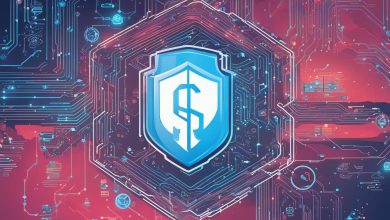
Technological advancements in the digital era have revolutionized the way we do business. As software development continues to accelerate, security challenges are broadening and becoming more complex. It’s essential to integrate security protocols from the ground up, and DevSecOps is the solution.
DevSecOps is a software development framework that merges development, operations, and security teams, ensuring security is integrated throughout the software development lifecycle. Embracing DevSecOps comes with significant benefits, including increased speed to market, enhanced security posture, and improved software quality.
Key Takeaways
- Embracing DevSecOps is crucial for enhancing business security infrastructure.
- Integrating security protocols from the ground up is essential in the digital era.
- DevSecOps is a software development framework that merges development, operations, and security teams.
- Implementing DevSecOps best practices can lead to significant benefits, including increased speed to market, enhanced security posture, and improved software quality.
Understanding DevSecOps and Security Integration
DevSecOps, the integration of development, operations, and security, has become increasingly important in today’s digital age. The traditional approach of tacking on security as an afterthought has proven to be ineffective, resulting in costly data breaches and compromised systems. Integrating security into every stage of the software development lifecycle, including secure software development practices, is crucial in today’s threat landscape.
DevOps security, also referred to as DevSecOps security, is a methodology that emphasizes the need for improved collaboration between developers, operations, and security teams. The goal is to create a unified approach to software development that prioritizes security from the outset.
Secure software development encompasses the implementation of processes, tools, and techniques that promote security throughout the software development lifecycle. It includes the identification of potential security threats and vulnerabilities and the implementation of security controls to mitigate risks.
Integrating Security
Integrating security into the software development process requires a shift in mindset that emphasizes the importance of security from the outset. This involves analyzing the potential security risks associated with each stage of the software development lifecycle and implementing appropriate security measures. Security integration must be an ongoing process that is actively managed to ensure continued effectiveness.
By integrating security across all elements of software development, organizations can create a culture of collaboration that improves the overall security posture of their systems. It also enables businesses to develop and deploy applications more quickly, without compromising on security.
When developing software, it’s crucial to ensure that all team members are aware of the potential security risks and have the necessary tools and training to mitigate them. Incorporating security into the DevOps process makes it easier to identify and remediate security issues early, reducing the likelihood of security incidents and minimizing their impact.
By prioritizing security throughout the software development lifecycle, organizations can create a culture of security-first thinking that supports continuous improvement and innovation in the development process.
Building a Security-first Approach
A security-first approach is essential to ensure that security is integrated from the beginning of the software development lifecycle. Developers need to be trained on secure coding practices and adhere to a secure development lifecycle in their development process to ensure that security is not an afterthought. Applying a security-first mindset is crucial to have a secure product at every stage of the development process.
The Secure Development Lifecycle (SDL) is a process that embodies the principles of security by design, making security an integral part of the software development process. The SDL consists of the following phases:
| Phase | Description |
|---|---|
| Requirements Analysis | Gather and define the security requirements for the application. |
| Design | Security design and architecture are defined in this phase. |
| Implementation | Developers use secure coding practices to implement the application. |
| Testing | Application security testing is performed to identify vulnerabilities. |
| Release | The application is released for deployment. |
| Maintenance | The application is monitored and maintained for security updates and patches. |
Implementing a security-first approach is essential in the DevSecOps process to ensure that security is at the forefront of every stage of development. Developers should be trained in secure coding practices and understand that any security vulnerabilities found in their code should be prioritized and resolved immediately.
Implementing Security Automation in DevSecOps
Incorporating security automation into DevSecOps processes can greatly improve an organization’s overall security posture. Automated security processes can reduce human error, enhance efficiency, and save time. Here are some best practices for implementing security automation in DevSecOps:
- Identify the right tools: There are several security automation tools available in the market. It’s crucial to evaluate and select the right tools that align with your organization’s specific needs.
- Automate security checks throughout the pipeline: Security checks should be automated at every stage, from code development to deployment. This ensures that security measures are implemented throughout the entire software development lifecycle.
- Enable continuous testing: Continuous testing helps identify and address any security vulnerabilities in real-time. It’s important to integrate automated testing tools into the DevSecOps pipeline to enhance the security of the software being developed.
Implementing security automation in DevSecOps requires a commitment to integrating security into the entire software development lifecycle. By following these best practices, organizations can enhance their security posture and improve the overall quality of their software products.
Overcoming Challenges in DevSecOps Implementation
Implementing DevSecOps can present challenges for organizations, but with the right approach and best practices, these challenges can be overcome. Below are some DevSecOps best practices for overcoming challenges:
Cultural Change
Implementing DevSecOps requires a cultural shift and a change in mindset. Organizations need to move away from siloed development and security teams and adopt a collaborative approach. This requires building trust among teams, encouraging open communication, and promoting a shared responsibility for security.
Continuous Improvement
DevSecOps is an ongoing process that requires continuous improvement. Organizations should adopt agile methodologies to promote flexibility and adaptability. Continuous integration and continuous delivery (CI/CD) pipelines help to automate the software delivery process, ensuring that code is tested, built, and deployed quickly and efficiently.
Collaboration
Effective collaboration is one of the key factors in successful DevSecOps implementation. Development, operations, and security teams should work together in all stages of the software development lifecycle. This ensures that security requirements are built into the software from the ground up.
By following these best practices, organizations can overcome the challenges of implementing DevSecOps, resulting in a more secure software development process.
Benefits of Embracing DevSecOps
DevSecOps integration benefits organizations in several ways. By embracing DevSecOps best practices, organizations can strengthen their security infrastructure and improve overall business success rates. Here are some of the key benefits of implementing DevSecOps:
- Enhanced Security: DevSecOps integration incorporates security measures from the beginning of the development cycle, making it possible to detect and address security breaches early on.
- Improved Software Quality: DevSecOps focuses on quality assurance, which leads to better software quality and fewer vulnerabilities.
- Increase Speed to Market: Collaboration and automation in DevSecOps speed up the software development cycle, allowing organizations to get their products to market faster.
- Foster Culture of Collaboration and Innovation: DevSecOps promotes a culture of collaboration, innovation, and continuous improvement, which can boost employee morale and improve the overall business environment.
In conclusion, embracing DevSecOps best practices brings numerous benefits to organizations. It enhances security, improves software quality, increases speed to market, and fosters a culture of collaboration and innovation. By adopting a security-first approach and implementing DevSecOps practices, organizations can enhance their security infrastructure and grow their businesses.
Conclusion
In today’s ever-evolving threat landscape, it is crucial for organizations to adopt a secure development lifecycle and embrace DevSecOps best practices. By integrating security from the ground up, businesses can enhance their security posture and improve software quality.
Implementing DevSecOps may present challenges, such as cultural changes and the need for collaboration, but the benefits are significant. DevSecOps enables organizations to increase speed to market, foster a culture of innovation, and, most importantly, enhance business security infrastructure.
Secure Development Lifecycle
Ultimately, the success of DevSecOps implementation hinges on the adoption of a secure development lifecycle. By placing security at the forefront of the development process, businesses can establish a culture of security-first and ensure that security is integrated throughout the entire software development lifecycle.
By implementing a secure development lifecycle and embracing DevSecOps best practices, organizations can mitigate security risks and protect their assets from potential threats. It is crucial for businesses to recognize the importance of DevSecOps integration and take steps to establish a secure development lifecycle to improve their overall security posture.
FAQ
Q: What is DevSecOps?
A: DevSecOps is a practice that combines development, operations, and security to create a unified approach to software development. It emphasizes integrating security into every stage of the software development lifecycle.
Q: Why is integrating security important in DevSecOps?
A: Integrating security in DevSecOps is crucial because it helps identify and address security vulnerabilities early in the development process. By integrating security from the ground up, organizations can build more secure and robust applications.
Q: What are the best practices for implementing DevSecOps?
A: Some DevSecOps best practices include integrating security into the entire software development lifecycle, using secure coding practices, automating security processes, fostering collaboration between teams, and continuously improving security measures.
Q: How can security automation improve DevSecOps?
A: Security automation in DevSecOps can improve efficiency, reduce human error, and enhance overall security posture. Automated security processes can help identify vulnerabilities and respond to security incidents in a timely manner.
Q: What are the common challenges in implementing DevSecOps?
A: Common challenges in implementing DevSecOps include cultural resistance to change, lack of collaboration between teams, integrating security into existing workflows, and ensuring consistent security practices across the organization.
Q: What are the benefits of embracing DevSecOps?
A: Embracing DevSecOps offers numerous benefits, including enhanced security, improved software quality, increased speed to market, and a culture of collaboration and innovation. It helps organizations build more secure and resilient software.








